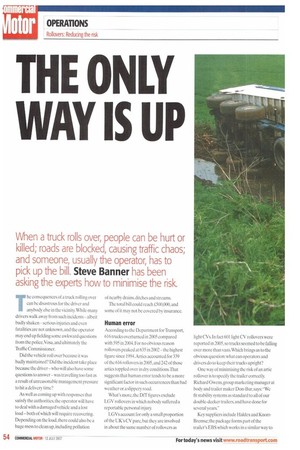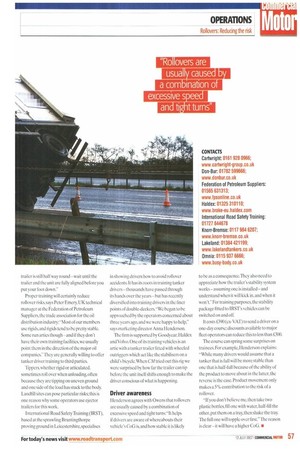THE ONLY WAY IS UP
Page 54

Page 55

Page 56

Page 57

If you've noticed an error in this article please click here to report it so we can fix it.
When a truck rolls over, people can be hurt or
killed; roads are blocked, causing traffic chaos; and someone, usually the operator, has to pick up the bill. Steve Banner has been asking the experts how to minimise the risk.
The consequences of a truck rolling over can be disastrous for the driver and anybody else in the vicinity. While many drivers walk away from such incidents —albeit badly shaken —serious injuries and even fatalities are not unknown, and the operator may end up fielding some awkward questions from the police,Vosa, and ultimately the Traffic Commissioner.
Did the vehicle roll over because it was badly maintained? Did the incident take place because the driver— who will also have some questions to answer — was travelling too fast as a result of unreasonable management pressure to hit a delivery time?
As well as coming up with responses that satisfy the authorities. the operator will have to deal with a damaged vehicle and a lost load— both of which will require recovering. Depending on the load, there could also be a huge mess to clean up, including pollution of nearby drains, ditches and streams.
The total bill could reach £500,000, and some of it may not be covered by insurance.
Human error
According to the Department for Transport, 616 trucks overturned in 2005 compared with 595 in 2004. For no obvious reason rollovers peaked at 635 in 2002 — the highest figure since 1994. Artics accounted for 339 of the 616 rollovers in 2005,and 242 of those artics toppled over in dry conditions. That suggests that human error tends to be a more significant factor in such occurrences than bad weather or a slippery road.
What's more, the DfT figures exclude LOV rollovers in which nobody suffered a reportable personal injury.
LGVs account for only a small proportion of the UK's CV pare, but they are involved in about the same number of rollovers as light CVs. In fact 601 light CV rollovers were reported in 2005,so trucks seemed to be falling over more than vans. Which brings us to the obvious question: what can operators and drivers do to keep their trucks upright?
One way of minimising the risk of an artic rollover is to specify the trailer correctly. Richard Owens, group marketing manager at body and trailer maker Don-Bur,says:"We fit stability systems as standard to all of our double-decker trailers, and have done for several years."
Key suppliers include Haldex and KnorrBremse; the package forms part of the trailer's EBS which works in a similar way to the electronic stability programmes filled to trucks and vans.
"It costs less than £100 to install a stability system when. a trailer is first built, so the price is neither here nor there when you consider the safety benefits," says John Cartwright, a director of body and trailer builder Cartwright Group." You can have it retrofitted to a trailer with F.FIS too, although if you do so you'll find the price is rather higher. it works well, as long as you ensure it's plugged in," Tanker trailer manufacturer Lakeland is also active in this field. Sales manager Doug Waits reports: "Some of the big oil companies monitor their tankers remotely so they can identify when and under what circumstances the device has been triggered.
Lakeland is equally aware of the need to keep the trailer's centre of gravity (CoG) as low as possible — a point echoed by both Owens and Cartwright.This is mandatory as far as tankers are concerned under the AD R regulations —Watts explains that trailer builders have to comply with an agreed mathematical formula.
Fitting a tank with an elliptical cross section helps because its CoG is lower than that of a cylindrical tank, he points out, adding: "Chassisless construction helps too because tanks as low as possible." Low-profile tyres make a useful contribution as well, he says:"They can lower the centre of gravity by a further 35mm."
Cartwright recommends lightweight materials to construct the body and roof to keep the CoG down:"The strength needs to be in the chassis and, in the case of a doubledecker trailer with a moveable upper deck, in the lifting columns" He cites a 13.6m triaxle straight-frame double-decker his company recently built for the Royal Mail which can accommodate 90 York cages (wheeled cages widely used by Royal Mail).
To minimise the weight of the roof and sides, Omnia panels were used.They are made from polypropylene with a honeycomb core and are lighter than alumini um. As a result of these and aluminium floors, Cartwright produced a trailer that is 2,000kg lighter than a standard step-frame double-decker.
Omnia panels can add f3.000 to a trailer's price, Owens points out,but the lighter superstructure should help combat one of the drawbacks of the straight-frame design. "A straight-frame trailer is inherently less stable than a step-frame' says Cartwright "The latter's coupling height will be higher. but the cargo deck at the back can be lower."
Focus on airflow
Operators anxious to keep their vehicles upright should also pay careful attention to the trailer's aerodynamics. says Owens. If the air hitting the front of the trailer as it travels along is not managed properly, it will create a series of side eddies, he explains. Their effect will be amplified if the truck encounters a cross-wind, increasing the pressure against the side of the vehicle.
A number of steps can be taken to smooth out the airflow along the top, sides and bottom of a trailer, including larger-radius cappings on the front corners to skirts that go all the way round.
But no matter how clever a trailer is designed,its stability depends on the way it is loaded. Owens says: "With a double-decker it's obvious that the heavy stuff should be placed on the bottom deck and the lighter stuff on the top one.'Thaes not the end of the story, though. because when you load the lower deck you should also ensure that the heaviest items are placed over the axles where possible rather than at the tractor-unit end."
And Cartwright offers some sound advice: "When the trailer is empty. make sure the top deck is lowered."
If the trailer is a curtainsider. ensure the curtains are fully tensioned, says Owens. If not, they will start to billow like a sail, making the vehicle more vulnerable to pressure from crosswinds. In fact Cartwright warns: "Potentially the most unstable trailer you can have is a tall, straight-frame curtainsider."
"We offer buckleless curtains with either a mechanical or an air-operated tensioning system,says Owens. "With the latter, all you have to do is press a button and it works automatically, removing any risk of driver error." Unsurprisingly, a lot of rollover accidents occur at roundabouts. What often happens is that the truck driver is travelling a bit too fast and turns the wheel too quickly from left to right and back again as the vehicle tackles a succession of tight turns going through the roundabout. If he or she is hauling a trailer with a tall load, there is the risk that the cargo will start to act like a huge pendulum, picking up momentum as the truck moves first one way then another.Then the rig will start to tip, possibly aided by an adverse camber on the road surface.
Tackling roundabouts
The effect will be magnified if the cargo has not been secured properly and starts to shift, but it can occur with a correctly restrained cargo too.The solution, of course, is for the driver to slow right down as he approaches the island, maintain a low speed as the truck goes through it, and turn the wheel as gently as possible.
One driver trainer advises: "Don't accelerate out of the roundabout while the trailer is still half way round -wait until the trailer and the unit are fully aligned before you put your foot down."
Proper training will certainly reduce rollover risks, says Peter Emery, UK technical manager at the Federation of Petroleum Suppliers, the trade association for the oil distribution industry:"Most of our members use rigicls, and rigids tend to be pretty stable. Some run artics thoughand if they don't have their own training facilities, we usually point them in the direction of the major oil companies." They are generally willing to offer tanker driver training to third parties.
Tippers, whether rigid or articulated, sometimes roll over when unloading, often because they are tipping on uneven ground and one side of the load has stuck to the body. Landfill sites can pose particular risks; this is one reason why some operators use ejector trailers for this work.
International Road Safety Training (IRST), based at the sprawling Rruntingthorpe proving ground in Leicestershire, specialises in showing drivers how to avoid rollover accidents. It has its roots in training tanker drivers thousands have passed through its hands over the yearsbut has recently diversified into training drivers in the finer points of double-deckers."We began to be approached by the operators concerned about three years ago, and we were happy to help," says marketing director Anna Henderson.
The firm is supported by Goodyear,Haldex and Volvo. One of its training vehicles is an artic with a tanker trailer fitted with wheeled outriggers which act like the stabilisers on a child's bicycle. When CM tried out this rig we were surprised by how far the trailer can tip before the unit itself shifts enough to make the driver conscious of what is happening.
Driver awareness
Henderson agrees with Owens that rollovers are usually caused by a combination of excessive speed and tight turns: "II helps if drivers are aware of whereabouts their vehicle's CoG is, and how stable it is likely to be as a consequence.They also need to appreciate how the trailer's stability system worksassuming one is installed and understand when it will kick in, and when it won't." For training purposes, the stability package fitted to IRST's vehicles can be switched on and off.
It costs £390 (ex-VAI) to send a driver on a one-day course; discounts available to major fleet operators can reduce this to less than £300.
The course can spring some surprises on trainees. For example, Henderson explains: -While many drivers would assume that a tanker that is full will be more stable than one that is half-full because of the ability of the product to move about in the latter, the reverse is the case. Product movement only makes a 5% contribution to the risk of a rollover.
"If you don't believe me, then take two plastic bottles, fill one with water, half-fill the other, put them on a tray, then shake the tray. The full one will topple over first." The reason is clear it will have a higher CoG. •
























































































































































































